
Fresh Vegetable Storage Tips For Your Refrigerator & Counter
{Includes Free Printable Chart}
Here are tips for fresh vegetable storage on your counter, and in the refrigerator, to keep them fresh and tasting good.
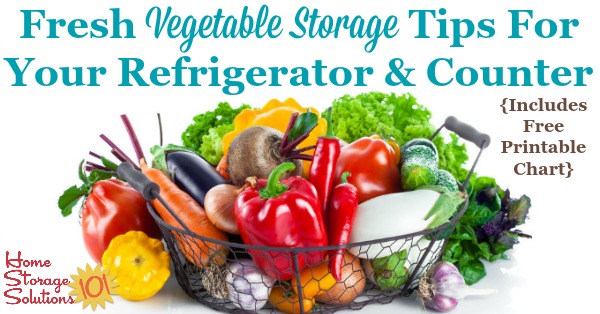
A free printable storage chart is also included below, after the tips are provided.
Many of us enjoy purchasing fresh veggies for meals and snacks, because they taste delicious and are good for us.
However, fresh vegetables, like any produce, are expensive, so you want to make sure it tastes great when you eat it, and that it is stored correctly so it doesn't go to waste before it can be enjoyed.
When you store your fresh vegetables correctly you will have the knowledge to help the vegetable stay at its peak, so it tastes amazing, and how to keep it from rotting or spoiling too quickly, and finally, how quickly you need to eat it to make sure it doesn't go to waste.
Where To Store: The Refrigerator Or On The Counter?
Most fresh vegetables are best kept in the refrigerator, and not out at room temperature.
Keeping your fresh veggies refrigerated keeps them crisp and good to eat, while slowing down deterioration which causes the vegetables to get soggy, mushy, or spoil.
There are a couple of exceptions to this rule, which I'll list. The first is tomatoes, which should not be placed in the refrigerator at least until ripe, and then their quality deterioates if they must be refrigerated. Of course, tomatoes are not actually vegetables at all, but instead fruits, so if you want to know more about them check out the fresh fruit storage tips article here.
The other main exceptions, that should not be stored in the refrigerator, are potatoes and onions (such as red, yellow and white onions), which are root vegetables.
Neither potatoes nor onions (exeption, green onions) should be placed in the refrigerator, but they shouldn't be left on the counter either, but instead in a cool dark place, such as inside a pantry, for the best storage. You can learn more about storing potatoes and onions in this pantry food storage chart here.
Finally, some people do not like to place cucumbers in the refrigerator, arguing the cool air within the fridge harms the cucumber's texture and flavor. If you feel that way then you'll need to eat your cucumbers quickly after purchase since they'll last for a little while on the counter, but not nearly as long as they'll last in the refrigerator.
Make Sure You're Putting Your Veggies In The Right Place Inside Your Refrigerator
When I say generally it is best to put your fresh vegetables in the refrigerator for storage, please note that not everywhere in your refrigerator is equally as good to store these fresh foods. Instead, the amount of humidity that certain vegetables require is different than what is best in the more open shelves of your fridge.
That's why refrigerators typically come with some drawers, also often called crispers, where you place produce.
To learn more about what these crisper drawers do, and how much humidity various types of produce need, make sure to check out the refrigerator storage chart here on the site.
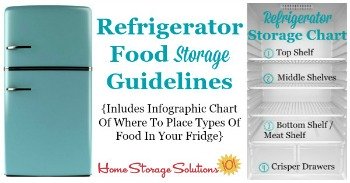
Why Each Type Of Vegetable Should Be Treated Differently When Deciding On Storage
As much as I like general rules, vegetables are also different in various respects.
For example, some vegetables dry out and need to be kept moist, while others need air circulation to prevent excess moisture which causes early spoilage.
That means that while you should keep the general rules in mind, you also need to remember some quirks about the individual types of vegetables you enjoy eating, and how they should be stored.
The chart below provides you with more information about this, for many of the most common types of vegetables.
How Long Various Vegetables Will Last In Your Refrigerator Or On Counter
Here's the chart which tells you how long various vegetables will last in your fridge, typically, or on the counter, as well as special storage instructions unique to that type of veggie. (The printable version of the chart is below, so scroll down to find it!)
| Vegetable | Storage Time In Fridge | Additional Notes |
|---|---|---|
| Artichokes | 1 week | If stems are still attached place stems in container of water and refrigerate. |
| Asparagus | 3 days | Either place upright in glass with inch of water in refrigerator, or wrap stem ends in damp paper towels to keep mouist, while refrigerated. |
| Basil, fresh | 5 days | Wash and dry, then wrap in damp paper towels and place in resealable plastic bag in refrigerator. |
| Beets | 2 weeks | Remove leafy tops before refrigerating. |
| Broccoli | 5 days | Keep dry, with air able to circulate, to prevent spoilage. |
| Brussels sprouts | 5 days | Place unwashed sprouts in paper bag in refrigerator crisper. |
| Cabbage | 1 week | Store in perforated bag in crisper, and do not wash until right before use. |
| Carrots | 2 weeks | Remove leafy tops before refrigerating. |
| Cauliflower | 1 week | Keep dry, with air able to circulate, to prevent spoilage. |
| Celery | 1 week | Wrap tightly in aluminum foil, and refrigerate. |
| Corn | 3 days | Leave in husk. Use quickly, as the older it is the starchier. |
| Cucumber | 1 week | Wrap in plastic wrap, and the refrigerate. Can also be left on the countertop, which some say keeps a better flavor. |
| Egglplant | 1 week (or less) | Whole egglplant may last longer stored in a cool place, but outside the refrigerator. Use quickly, can be perishable. |
| Green beans | 1 week | Store in plastic bag in the crisper. |
| Green onions | 5 days | Wrap the ends of the onions in a damp paper towel, place inside a plastic bag, and then refrigerate. |
| Greens | 5 days | Includes Collards, Kale, Spinach, and Swiss Chard. Wrap in damp paper towels, and store in perforated bag. |
| Herbs, fresh (except basil) | 5 days | Store stems in damp paper towel, or stick stems in a glass of water in refrigerator. |
| Lettuce (Iceberg & Romaine) | 5 days (whole) | Wrap in damp paper towels, and store in perforated bag. |
| Lettuce (Arugula & Mesclun) | 3 days | Wrap in damp paper towels, and store in perforated bag. |
| Lima beans | 3 days | Leave in shell. |
| Mushrooms | 2-3 days | Store in paper bag with a lightly damp paper towel inside to keep mushrooms moist. |
| Parsnips | 2 weeks | Remove leafy tops before refrigerating. |
| Peas (Snow & Sugar Snap) | 3 days | Leave in shell. Keep dry, with air able to circulate, to prevent spoilage. |
| Peppers | 1 week (whole), or 2-3 days (cut) | Once chopped, wrap in paper towel and place in an airtight container in refrigerator. |
| Radishes | 2 weeks | Remove leafy tops before refrigerating. |
| Rhubarb; | 3-5 days | Place stalks in a plastic bag to retain moisture, and place in crisper. |
| Squash, butternut | 4 days (once cut) | Fresh and uncut, it can be stored in a dark cool place like a basement or closet, for up to 2-3 months. Once cut it needs to be refrigerated in an airtight container and used quickly. |
| Squash, yellow | 5 days | Store in perforated bag in crisper, and do not wash until right before use. |
| Turnips | 2 weeks | Remove leafy tips before refrigerating. |
| Zucchini | 5 days | Store in perforated bag in crisper, and do not wash until right before use. |
Printable Fresh Vegetable Storage Chart {Cheat Sheet}
Here is the printable version of the fresh vegetable storage chart, which answers the question of how long will certain veggies last in the refrigerator, or on the counter, when you use the best storage methods.
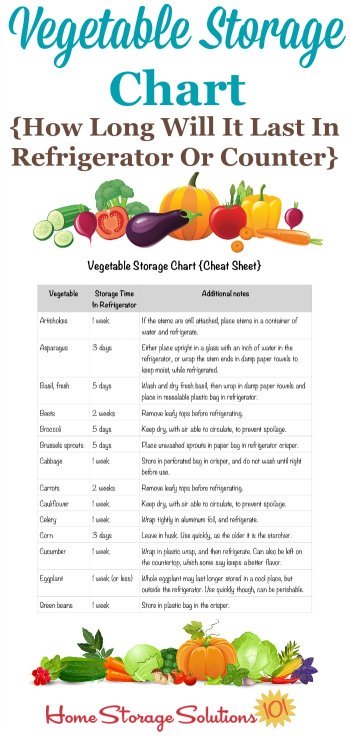
Click here to get your Cheat Sheet (3 pages) (opens into PDF)
I've created a printable version of this information for you so it is easier for you to reference when organizing your refrigerator as part of the Organizing Refrigerator & Freezer Challenge.
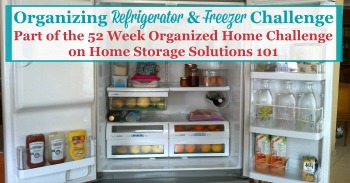
Do You Want To Know How To Store Fresh Fruit Too?
I've written a companion article to this one, all about tips for storing fresh fruit in your refrigerator, counters and pantry. You can check it out here, as well as get a free printable fresh fruit storage chart.
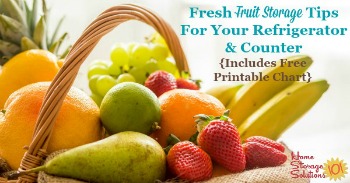
Other Printable Forms You May Like
Here are some additional printable forms about food storage, including other cheat sheets with storage times for food, that you may find helpful.
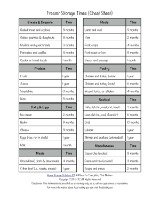 Freezer Storage Times {Cheat Sheet} |
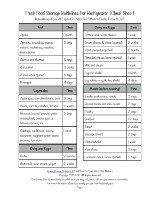 Refrigerated Food Storage Guidelines {Cheat Sheet} |
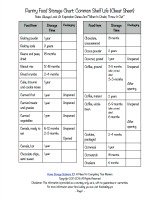 Pantry Food Storage Chart {Cheat Sheet} |
Funny Because It's True!
Have you ever thought, "I wish I was the person I thought I could be when I bought all this produce."
I think we've all been there! Hopefully these tips will help you keep your produce fresher, so it will all actually get used!
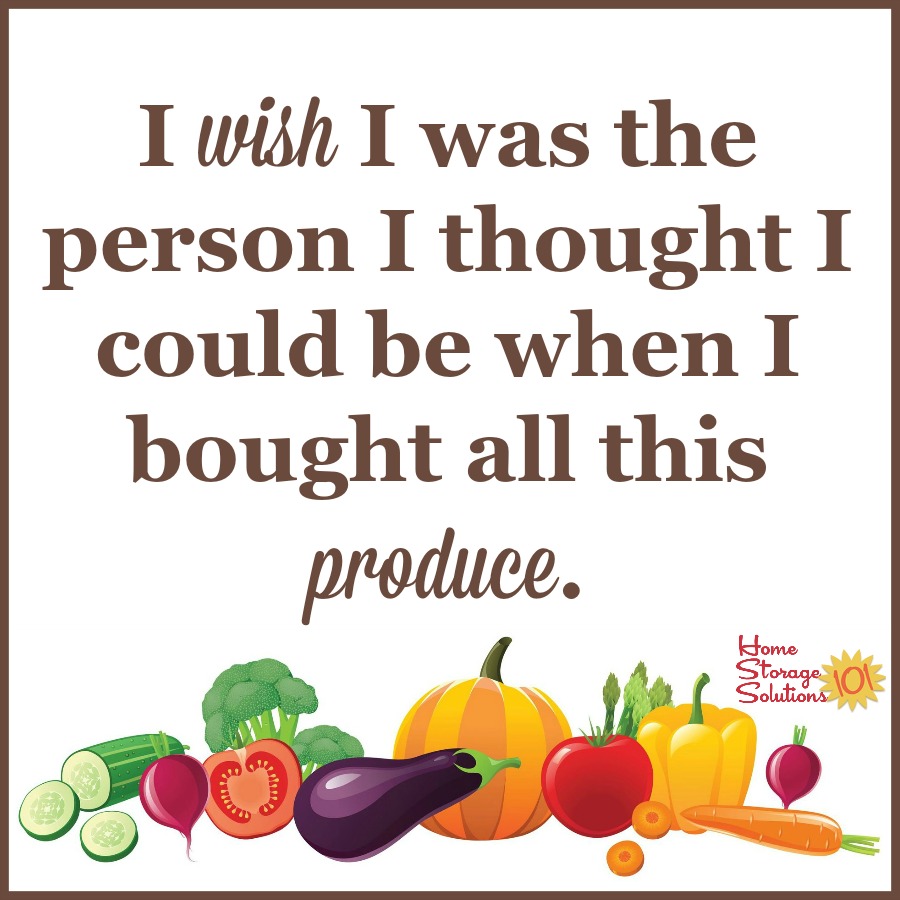

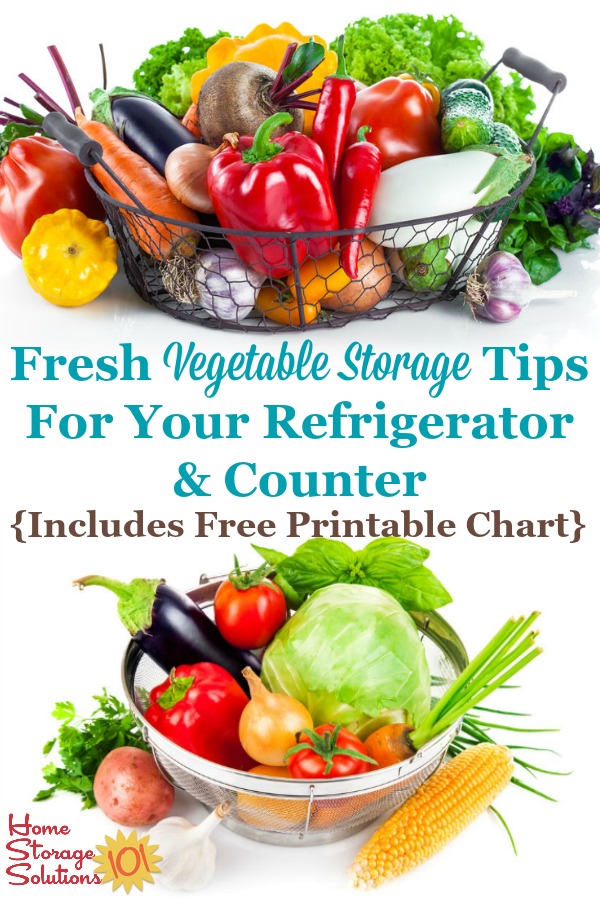











Share Your Comments, Tips & Ideas
I would love to hear from you, sharing your thoughts, questions, or ideas about this topic, so leave me a comment below. I try to always respond back!